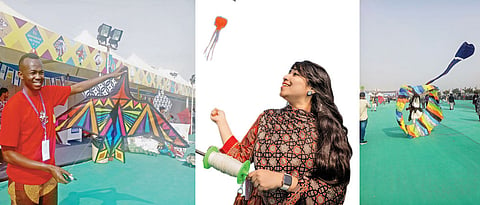

India is a land of varied cultures and festivals are held here almost on a daily basis. One such festival, the Kite Festival -- of flying kites and cutting away the manjha (special kind of thread coated with glass powder and rice paste) of others’ kites to win a friendly battlefield -- will make you happy and joyous. Kites (patang, or guddi in Hindi) are made up of a diamond-shaped tissue paper and two strips of bamboo, and when manoeuvred with the manjha held by human hand, soar high in the sky.
The festival associated with kite flying is celebrated on different occasions throughout India, namely, on Makar Sankranti in Gujarat and Rajasthan, Ganga Dusshera in Uttar Pradesh, Independence Day in Delhi, Vishwakarma Puja in West Bengal and so on. The skies are filled up with millions of kites, all trying to cut each other down. It’s a sort of picnic at every rooftop, with participating families enjoying all their daily meals along with kiteflying throughout the day.
This year, I had the chance to visit the capital of one of the most vibrant states in India, Gujarat and participate in the most colourful International Kite Festival 2020 in Ahmedabad organised by the Gujarat Tourism. In Gujarat, it is celebrated on the day of Uttarayan, and is one of the major festivals of the state attended by almost every renowned kite flyer in the world. Hosted every year at the Sabarmati riverfront since 1989, the festival attracts master kite flyers from Argentina, Vietnam, the Netherlands, Russia, Poland, Philippines and others. The sky turns into a riot of colours with traditional as well as unconventional kites in different shapes and sizes.
Almost every normal activity in Gujarat shuts down on this day and everyone, from kids to young to seniors, takes to the rooftops to fly kites. This is a festival where there is no age bar, and people from all walks of life enthusiastically participate in the festivity.
“When you see kites soaring high, you see the reflection of your progress as well. So, it can be called a festival of growth and prosperity,” said Gujarat governor, Devvrat Acharya, who unveiled the festival along with Chief Minister Vijay Rupani. “Thanks to this festival, the kite-making business in Gujarat has grown seven times in the last 10 years,” he informed, adding, “It has helped all those who are in the business of making kites and other related products.”
The flyers
At the riverfront, I found a deluge of kites in the sky in various shapes like animals, fish, colourful masks and so on. One had Mahatma Gandhi printed on it, while some kites had social messages on them. The sculpture kites comprised a chain of 5-20 small kites.
Mike Tysiac from Germany grabbed everyone’s attention as he flew his 40-feet-long inflatable dolphin kite. In Gujarat, how can one forget Mahatma Gandhi,” said another foreigner, who was flying a kite with a sketch of Mahatma Gandhi on a rectangular kite.
Many foreigners tried to depict their culture through this festival. A couple from Bali participated with kites painted in vivid colours. “We have travelled across the globe but few places have such a kite culture as Ahmedabad. There is not much experimenting with shapes here but January 14 is something of an experience for a foreigner. We have been fortunate to see the mood on house terraces in the state,” said Aude Maincent from France.
Indian fliers were there in huge numbers and they too were excited. A member of a kite-flyers’ group from Jaipur that had a giant-sized kite, informed, “We participate in almost every kite festival held in India. But this one is the best and the biggest kite festival we have ever attended.”
I also spotted faces of many politicians decorating the kites; Prime Minister Narendra Modi being prominent among them.
I felt a visit to the Patang Bazar was inevitable. And there I went into a congested colony in Jamalpur, where almost every resident of a predominantly Muslim locality is engaged in making kites and the paraphernalia with it. It’s like a cottage industry here with almost 1200 families engaged in it. A kite maker informed me that it takes almost nine members of a family to make a kite with the decorations being done by the women.
Food at the fest
Any festival is incomplete without food in Gujarat and I also enjoyed various types of stuff from the food stalls set up specially for the festival. I preferred to gorge on the tasty traditional food specially made for Uttarayan, like Undhiyu (spicy, baked mix of winter vegetables) and Chikkis (made from til, peanuts and jaggery). There was food from other parts of India like Khichdi, Chura, sweets made of til (sesame seeds) and peanuts such as tilgul, chikki etc from UP, Bihar, Jharkhand, Delhi, Punjab, and traditional sweets from Bengal like Pithey made of rice flour, coconut, milk and date palm jaggery.
